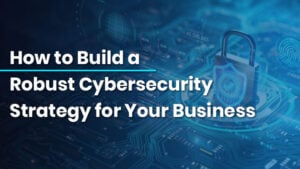
Managed vs. In-House IT: What’s Right for Your Business?
Managed vs. In-House IT: What’s Right for Your Business? Introduction Technology is no longer a support function but a key enabler of innovation, scalability, and
🔥 Limited Time Offer 🔥 Get the Premium Monthly Plan for just $11.99 $19.99. Use code UPSKILLNOW and unlock exclusive benefits 👉Subscribe Now!

Managed vs. In-House IT: What’s Right for Your Business? Introduction Technology is no longer a support function but a key enabler of innovation, scalability, and

Google Workspace vs. Microsoft 365: Which is Better for Your Team? Introduction Choosing the right productivity suite is essential for any business aiming to

How to Build a Robust Cybersecurity Strategy for Your Business Introduction In the modern digital landscape, cybersecurity is no longer just an IT concern,
Table of Contents
In today’s digitally connected world, ensuring the security of your business infrastructure is paramount. The rise of cyber threats demands a proactive approach to safeguard sensitive data, maintain operational continuity, and protect against potential breaches.
IPSpecialist is a platform that stands out for its diverse Courses in Cybersecurity. IPSpecialist offers online training and career support, serving as a centralized hub for individuals seeking Cybersecurity knowledge. This article explores essential best practices that businesses can implement to fortify their infrastructure security.
Infrastructure security involves strategies and procedures aimed at ensuring the reliability, robustness, and integrity of an organization’s IT assets. It encompasses networks, systems, data centers, and various components forming the backbone of organizational activities.
The four levels of infrastructure security are network, physical, application, and data.
Protecting data’s availability, integrity, and confidentiality, regardless of whether it’s in use, in transit, or at rest, is the primary goal of data-level infrastructure security.
Applications must be strengthened to withstand unauthorized interventions and safeguarded against potential dangers, such as SQL injections that attack databases.
Preventive steps include regularly applying patches, establishing stringent input validation, embedding authentication and authorization procedures into APIs, and conducting frequent security testing.
When it comes to corporate network infrastructure security, a firewall frequently serves as the first line of defense, creating a barrier between potential threats and the protected network of your company.
Network infrastructure security aims to safeguard data as it enters, leaves, and moves across the network. Everything from traffic encryption to firewall control is covered by this method.
At this stage, appropriate identity and authentication mechanisms are also essential. Moreover, Multi-Factor Authentication (MFA), which requires several verification steps before allowing access to network resources, strengthens network defenses.
Physical infrastructure security is equally essential as network security. It includes fencing, surveillance cameras, backup generators, and secured doors.
While cybersecurity protects online assets, it does not defend against physical theft, vandalism, or natural disasters. Therefore, a comprehensive physical security strategy should encompass data recovery protocols, ideally utilizing offsite backups in multiple geographic areas.
Naturally, the primary benefit of infrastructure security lies in its ability to protect your organization from financial losses arising from cybersecurity threats.
Along with this, a robust infrastructure security system ensures:
Companies are increasingly acknowledging the risks associated with a deficient cybersecurity strategy, realizing the potential impact on productivity, goodwill, and financial performance. To ensure genuine safety, it is essential to develop a clear plan for addressing future security needs. The following steps can enhance your cybersecurity strategy:
A security risk assessment evaluates and enhances your company’s cyber resilience through collaboration from various groups and data owners. Management commitment is crucial for allocating resources and implementing necessary cybersecurity solutions. Additionally, determining the value of company data is integral for effective cyber risk management. Conducting an IT infrastructure audit enables the identification of critical data sources, storage locations, and vulnerabilities, allowing for a thorough risk assessment.
Aligning business goals with your cybersecurity strategy is crucial for success in critical infrastructure protection. Clearly defined corporate goals make it easier to integrate the cybersecurity framework. To develop effective security goals, focus on establishing reasonable expectations, assessing security maturity, understanding your company’s risk appetite, and taking immediate action on simple tasks, addressing challenges as they arise.
Cybercriminals employ advanced tactics to target businesses of all sizes and industries. To navigate the current business landscape, it’s crucial to have a robust plan for managing both physical and cybersecurity across vital systems and assets. Implementing the mentioned cybersecurity practices will safeguard your technology infrastructure, enhance cyber resilience, and prevent malicious activities that could jeopardize your information system resources.
As strategy assessments and policy plans near completion, it’s time to allocate tasks and prioritize remedial efforts. Assign cybersecurity tasks to internal teams based on priority. Utilize the Project Management team if available, or take on a leadership role to coordinate activities if no project team exists. Set realistic deadlines, allowing for more time than initially anticipated.
Ensuring infrastructure security in the future requires a proactive and comprehensive approach that addresses evolving threats, technological advancements, and the dynamic nature of IT environments. Here are key strategies and considerations to enhance infrastructure security:
Securing your business infrastructure demands a proactive and comprehensive approach. As technology evolves and cyber threats become more sophisticated, organizations must continually adapt their strategies to protect against a wide range of risks. A resilient infrastructure security strategy is crucial for the ongoing success and stability of your business.
Infrastructure security refers to the set of measures and practices designed to protect the underlying technology infrastructure of an organization. This infrastructure includes hardware, software, networks, data centers, servers, and other components that support the organization’s operations.
It is impossible to overestimate the significance of infrastructure security since it is essential for preserving an organization’s resources, guaranteeing the ongoing conduct of business, and defending against a variety of threats.
The future of infrastructure security involves a proactive and comprehensive approach that addresses evolving threats, technological advancements, and the dynamic nature of IT environments.
© 2025 All rights reserved | Privacy Policy | Terms and Conditions | Sitemap | Cookie Policy




